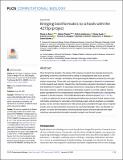Files in this item
Bringing bioinformatics to schools with the 4273pi project
Item metadata
| dc.contributor.author | Bain, Stevie | |
| dc.contributor.author | Plaisier, Heleen | |
| dc.contributor.author | Anderson, Felicity | |
| dc.contributor.author | Cook, Nicola | |
| dc.contributor.author | Crouch, Kathryn | |
| dc.contributor.author | Meagher, Thomas Robert | |
| dc.contributor.author | Ritchie, Michael Gordon | |
| dc.contributor.author | Wallace, Edward | |
| dc.contributor.author | Barker, Daniel | |
| dc.date.accessioned | 2022-02-04T12:30:03Z | |
| dc.date.available | 2022-02-04T12:30:03Z | |
| dc.date.issued | 2022-01-20 | |
| dc.identifier | 277566583 | |
| dc.identifier | 9f12638b-d3c5-4445-86cf-bcd9afdb3df9 | |
| dc.identifier | 85123296974 | |
| dc.identifier | 000747702400001 | |
| dc.identifier | 35051174 | |
| dc.identifier.citation | Bain , S , Plaisier , H , Anderson , F , Cook , N , Crouch , K , Meagher , T R , Ritchie , M G , Wallace , E & Barker , D 2022 , ' Bringing bioinformatics to schools with the 4273pi project ' , PLoS Computational Biology , vol. 18 , no. 1 , e1009705 . https://doi.org/10.1371/journal.pcbi.1009705 | en |
| dc.identifier.issn | 1553-734X | |
| dc.identifier.other | ORCID: /0000-0001-7913-8675/work/106837989 | |
| dc.identifier.other | ORCID: /0000-0003-4462-0116/work/106838150 | |
| dc.identifier.uri | https://hdl.handle.net/10023/24810 | |
| dc.description | The work was supported by the Science and Technology Facilities Council (STFC) under Grants STFC ST/R000328/1 (including salary to S.A.B., D.B., H.P., T.R.M. and non-salary costs) and STFC ST/T000872/1 (including salary to S.A.B., D.B., K.C., T.R.M. and non-salary costs), the Darwin Trust of Edinburgh (https://darwintrust.bio.ed.ac.uk; including salary to S.A.B. and H.P. and non-salary costs), the Wellcome Trust-University of Edinburgh Institutional Strategic Support Fund under Wellcome Trust Grant number 204804/Z/16/Z (salary to H.P.), a Public Engagement with Genetics Tier 2 Grant from the Genetics Society (https://genetics.org.uk; non-salary costs), the Natural Environment Research Council (NERC) under Grant NE/P000592/1 (including salary to N.C. and M.G.R. and non-salary costs), the Biotechnology and Biological Sciences Research Council (BBSRC) under Grant BB/S018506/1 (including salary to F.A. and non-salary costs), the School of Biological Sciences at the University of Edinburgh (https://www.ed.ac.uk/biology; including salary to S.A.B. and H.P. and non-salary costs) and its Institute of Evolutionary Biology (https://www.ed.ac.uk/biology/evolutionary-biology; non-salary costs), the Access for Rural Communities project (ARC) at University of St Andrews (https://www.st-andrews.ac.uk/study/access/projects/arc; non-salary costs) and the Engineering and Physical Sciences Research Council (EPSRC) under Grant EP/V52038X/1 (including salary to S.A.B. and non-salary costs). E.W.J.W. is supported by a Sir Henry Dale Fellowship jointly funded by the Wellcome Trust and the Royal Society [208779/Z/17/Z] (including salary to E.W.J.W.). | en |
| dc.description.abstract | Over the last few decades, the nature of life sciences research has changed enormously, generating a need for a workforce with a variety of computational skills such as those required to store, manage, and analyse the large biological datasets produced by next-generation sequencing. Those with such expertise are increasingly in demand for employment in both research and industry. Despite this, bioinformatics education has failed to keep pace with advances in research. At secondary school level, computing is often taught in isolation from other sciences, and its importance in biological research is not fully realised, leaving pupils unprepared for the computational component of Higher Education and, subsequently, research in the life sciences. The 4273pi Bioinformatics at School project (https://4273pi.org) aims to address this issue by designing and delivering curriculum-linked, hands-on bioinformatics workshops for secondary school biology pupils, with an emphasis on equitable access. So far, we have reached over 180 schools across Scotland through visits or teacher events, and our open education resources are used internationally. Here, we describe our project, our aims and motivations, and the practical lessons we have learned from implementing a successful bioinformatics education project over the last 5 years. | |
| dc.format.extent | 12 | |
| dc.format.extent | 874844 | |
| dc.language.iso | eng | |
| dc.relation.ispartof | PLoS Computational Biology | en |
| dc.subject | LB1603 Secondary Education. High schools | en |
| dc.subject | LB2300 Higher Education | en |
| dc.subject | QA75 Electronic computers. Computer science | en |
| dc.subject | QH301 Biology | en |
| dc.subject | Ecology, Evolution, Behavior and Systematics | en |
| dc.subject | Genetics | en |
| dc.subject | Molecular Biology | en |
| dc.subject | Computational Theory and Mathematics | en |
| dc.subject | Ecology | en |
| dc.subject | Modelling and Simulation | en |
| dc.subject | Cellular and Molecular Neuroscience | en |
| dc.subject | T-NDAS | en |
| dc.subject.lcc | LB1603 | en |
| dc.subject.lcc | LB2300 | en |
| dc.subject.lcc | QA75 | en |
| dc.subject.lcc | QH301 | en |
| dc.title | Bringing bioinformatics to schools with the 4273pi project | en |
| dc.type | Journal article | en |
| dc.contributor.sponsor | Science & Technology Facilities Council | en |
| dc.contributor.sponsor | NERC | en |
| dc.contributor.institution | University of St Andrews. School of Biology | en |
| dc.contributor.institution | University of St Andrews. Centre for Biological Diversity | en |
| dc.contributor.institution | University of St Andrews. Scottish Oceans Institute | en |
| dc.contributor.institution | University of St Andrews. St Andrews Sustainability Institute | en |
| dc.contributor.institution | University of St Andrews. Centre for Research into Ecological & Environmental Modelling | en |
| dc.contributor.institution | University of St Andrews. St Andrews Bioinformatics Unit | en |
| dc.contributor.institution | University of St Andrews. Institute of Behavioural and Neural Sciences | en |
| dc.identifier.doi | https://doi.org/10.1371/journal.pcbi.1009705 | |
| dc.description.status | Peer reviewed | en |
| dc.identifier.grantnumber | ST/T000872/1 | en |
| dc.identifier.grantnumber | NE/P000592/1 | en |
This item appears in the following Collection(s)
Items in the St Andrews Research Repository are protected by copyright, with all rights reserved, unless otherwise indicated.

